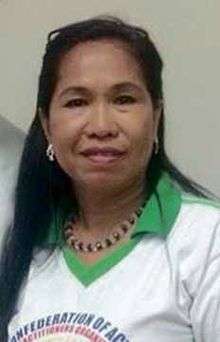Rubylita Garcia
| Rubylita Garcia | |
|---|---|
 | |
| Born | ca. 1962 |
| Died |
April 6, 2014 Bacoor City, Cavite Province, Philippines |
| Cause of death | Murder by gunshot |
| Resting place | Trinity Garden, Bacoor City |
| Nationality | Filipino |
| Occupation | Radio Host, Reporter, Journalist |
| Employer | Remate, dwAD |
| Children | 1 |
Rubylita Garcia (ca. 1962 – 6 April 2014) was a female Filipino host for a local radio talk show on channel dwAD and a journalist for the daily tabloid Remate in Bacoor City, Philippines. She reported on corruption in the Philippines.[1] She was murdered in 2014.
Personal
Rubylita Garcia was a 52-year-old widow who had one son, Tristan, and a granddaughter.[1][2] She was buried in Trinity Garden in her hometown of Bacoor City after a Mass at the St. Michael Church.[3]
Career
Garcia was a reporter for over 25 years.[4] She was an investigative journalist reporting for Remate, the Pilipino Times, and also worked for the radio station dwAD in Cavite province.[1][5] Garcia was president of a group of journalists, which was called the Confederation of Active Media Practitioners Organization, in the area of Calabarzon. She was also a member of the National Press Club (Philippines).[2][5][6]
Death
.svg.png)
She was gunned down by two men in front of her ten-year-old granddaughter, son, and sister-in-law in her home in Bacoor City.[1] Before she died, she said that the local police chief was the only one who wanted her dead, no conviction has been made however, only a temporary relief of duty.[2][7][8] She died on the way to the hospital and her family members were not physically harmed.[9]
The Philippine National Police formed a special investigation task force, but no one was captured.[9][10] One of the suspects was witnessed to be about 6 foot tall, in his thirties, with a tattoo of a cross on his neck and a tattoo on his arm.[1][9][10][11] A man was arrested during a busy bust operation in Cavite City, but further examination of the suspect from a witness declared that this was not one of the men who murdered Garcia.[10] No further reports have been made to the capture of these gunmen.
Context
From 2001 to 2014, 115 reported media workers have been killed in the Philippines.[12] 48 of these were work-related murders while only 36 were filed in court.[12] Under Philippines President Benigno Aquino III’s administration there have been 27 media killings from 2010 to 2014, 11 were work related while 16 were non-work related.[12] Out of the 11 work related murders, Garcia was the only person who was murdered in 2014 while 6 people were murdered in 2013.[12] The Philippines is ranked the 3rd worst country for journalists in CPJ’s impunity index.[9]
Impact
Irina Bokova, who is the director-general of UNESCO, said, "I condemn the murder of Rubylita Garcia. It is essential that the authorities of the Philippines do all they can to identify and bring to trial those responsible for this cowardly crime. Murderers cannot be allowed to set limits to journalists’ freedom of expression or on citizens’ rights to information."[13]
The National Press Club along with many other of the Philippines’ largest media organizations, mourned Garcia’s death.[8] Garcia’s death added to the journalistic turmoil in the Philippines, which resulted in many media practitioners having increased dissatisfaction and disappointment with the Aquino government’s ability to rectify and prevent media killings.[1]
Reactions
Bacoor’s Mayor, Strike B. Revilla, started a P 50,000 reward for anyone who would solve the case of Garcia’s murder.[8] Later, the P 50,000 reward was raised to P 100,000 and was then raised again to P 150,000 by Alab ng Mamamahayag (ALAM). This group rallied at the Cavite police headquarters, protesting their concerns of how long it was taking to investigate Garcia’s case.[4][10] Funeral marchers carrying Garcia’s casket during “A Walk For Justice” adopted the slogan “Justice For Ruby Garcia” and had it printed on their T-shirts which they wore while marching.[3]
See also
References
- 1 2 3 4 5 6 "Media groups, gov't condemn killing of Cavite reporter, 8 April 2014".
- 1 2 3 "Police colonel named 'brains' behind latest media killing, 7 April 2014".
- 1 2 "Police eye capture of reporter's killer with daughter's help, 16 April 2014".
- 1 2 "P150,000 offered for arrest of Cavite reporter's killers".
- 1 2 "Woman reporter shot dead in Philippines, 7 April 2014".
- ↑ "Palace extends condolences to family & relatives of slain Cavite journalist, 7 April 2014".
- ↑ "Dying Reporter Says Police Chief Wants Her Dead". Philippines Daily. 8 April 2014.
- 1 2 3 "Palace orders hunt down of Cavite journalist killers, 8 April 2014".
- 1 2 3 4 "Gunmen kill Filipino journalist in front of granddaughter, 7 April 2014".
- 1 2 3 4 "Reward for Rubylita Garcia case raised to P150K, 10 April 2014".
- ↑ "Tabloid reporter shot dead in Cavite, 7 April 2014".
- 1 2 3 4 "Of 115 media killings, only 36 cases filed in court since 2001 - PNP report to Senate, 20 May 2014".
- ↑ "Director-General calls for investigation into the murder of Philippines journalist Rubylita Garcia". UNESCOPRESS. April 19, 2014.
